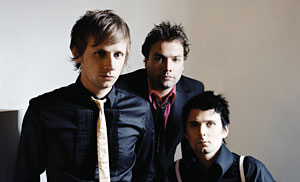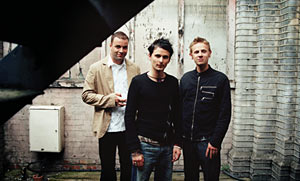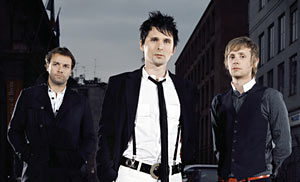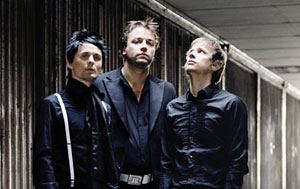Infinite Universe (2006fall Digizine article)
Infinite Universe
By Bill Murphy
It might seem slightly twisted to launch into a story on one of the UK’s most futuristic rock bands by conjuring up the early ‘60s instrumental work of the Tornados — the Joe Meek –produced quintet whose quirky lounge classic “Telstar” was an international hit — but in Matt Bellamy’s case, the reference is more than apt. “My dad was in that band,” says the dynamic lead singer of Muse, “and for the time, their music was quite forward-thinking. Of course, now that we listen back to it, sometimes it reminds you of a sci-fi B-movie from back then, you know? I was trying to capture a little bit of that retro sci-fi mood with some of the songs on this album.”
The album, Black Holes and Revelations (Warner Bros.), marks the first time that Muse has committed fully to the processing power of Pro Tools|HD. And while the band — Bellamy (who also plays guitars and keyboards), Chris Wolstenholme (bass and backing vocals), and Dominic Howard (drums) — still rely on a wealth of analog outboard gear and vintage synths to harness their lush, multi-layered sonic experience, they’ve also found a new source of creative freedom in the digital domain. From Pro Tools in the studio to Digidesign’s VENUE system on stage, the latest mission of Muse is all about exploring fresh possibilities in sound.
APPROACHING WARP SPEED
“This was a very demanding album in terms of what we needed from our equipment,” Bellamy says. “I think if we were working only with tape like we did on the first album Showbiz, 1999], we’d probably still be working on it now.”
Unlike the last three Muse albums, virtually every song on Black Holes and Revelations required a different production approach, from the stripped-down intimacy of the dreamy ballad “Soldier’s Poem” to the glam-rock aggression of “Starlight.” Meanwhile, constant changes in locale — five studios in four countries for tracking and mixing, over a period of about seven months — only added to the complexity of the project. For the band and producer Rich Costey, this meant that work had to proceed quickly and efficiently, regardless of the capabilities of the studio they were in.
“The first studio we worked at was Miraval in France,” recalls Costey, who co-produced and mixed the band’s last album Absolution, and has worked with an A-list of artists that includes Rage Against the Machine, Audioslave, Franz Ferdinand, the Mars Volta, and Mastodon. (Costey also got an early start on Pro Tools during his tenure with composer Philip Glass at Looking Glass Studios, beginning in 1996.) “We started off using tape a little bit, where we would record basic tracks on analog and then edit them in Pro Tools. But that process took a long time; the studio was great, but it was difficult to get things done very quickly. We ended up just scrapping the tape so we could work faster, which is why most of the album was just recorded straight into Pro Tools.”
Eventually the band came to New York for the bulk of their multi-tracking sessions at Avatar and Electric Lady. When they headed back to Europe to record a string section and begin vocal overdubs and lead retakes, Bellamy decided to expedite the process even further by having his own portable Pro Tools|HD rig — complete with a custom-built flight case — sent to Office Meccaniche Studios in Milan, Italy.
“That was where the portability was very important,” Bellamy says, “because I did some work at home and in a couple of different studios in Milan. By having the flight case made, that obviously guarantees that we can move around with Pro Tools to wherever we want. I just have to plug in a monitor and a mouse and we’re off.”
"We can move around with Pro Tools to wherever we want. I just have to plug in a monitor and a mouse and we're off." — Muse Lead Singer, Guitarist, and Keyboardist Matt Bellamy
For Costey, the additional setup was also a crucial time-saver, especially when he began preparing for the mixing phase. “We ended up having two rooms going,” he explains, “so Matt was able to do quite a lot of vocals. He’d set up the track, get in the vocal booth and do a take, and then walk back into the other room and hit stop. Over the holiday break, he would upload MP3s for me to listen to and we would sort through those together. Chris was also punching in some of his own background vocals — just working by himself until he had the sound he wanted. I think enabling the artists themselves to do stuff like that on their own time is a big step because it keeps everybody engaged in the creative process.”
MANY WORLDS THEORY
Having chosen Pro Tools as their primary tracking medium, the members of Muse took full advantage of the program’s capacity. Dense layers of vocals in the style of vintage Freddie Mercury and Queen (the operatic rock chorus of “Supermassive Black Hole” being a prime example) are the most noticeable result, while the seamlessly stacked musical strata of songs like “Exo-Politics” — a multi-hued mixture of heavy guitars and bass, pounding drums, and strange synth washes from an ARP 2600, EMS Synthi, and Buchla modular — display the band’s use of Pro Tools as a compositional enabler.
“That song went in several different directions,” Costey explains, “which wouldn’t have happened without Pro Tools. To start we tried it with a traditional band sound, then we took it in another direction where it was all synthesizers, and then another where it was just weird effects. The final version ended up being an amalgam of all three, and I think it’s a much richer song because of it. We’re basically using Pro Tools to arrange and compose — and we can re-approach and re-arrange the same song without having any fear of losing what we started with.”
A similar tactic propelled the final version of “Starlight,” which went through several stylistic interpretations before Bellamy tackled the lead vocal. “It wasn’t until I actually came in to record it,” he explains, “that I automatically felt like the song was pulling me towards a more aggressive tone than the take I was listening to. Fortunately we had all the different-styled takes layered on top of each other, and we were able to pull up a much more aggressive drum take, with more aggressive bass and guitars going with that, and that helped me do the vocal. We don’t do that kind of mixing and matching a lot — normally we’re quite committed to an arrangement before we even start recording — but I suppose the freedom of Pro Tools led us to what worked.”
The same held true when it came to grouping and mixing the album’s backing vocals. Costey takes “Soldier’s Poem” as a case in point. “Both Matt and Chris sang on that song,” he says, “and there were quite a lot of vocals laid down, so we would just comp and choose which takes were the best. We had them on different playlists, and that sort of thing is much easier to do in Pro Tools.”
"We're basically using Pro Tools to arrange and compose — and we can re-approach and rearrange the same song without having any fear of losing what we started with." — Producer Rich Costey
Costey usually does submixes of the vocal groups that will become part of the final mix, and then bounces them to half-inch tape. “I’m quite a big fan of tape saturation,” he says, referring to the “cohesive” effect of analog tape, “as well as analog delays like the Echoplex and Binson, which we used on a lot of vocal treatments.” From the tape machine, the vocals would be flown back into the computer and then offset to fix any latency issues. “It doesn’t sound all that glorious,” Costey jokes of the technique, “but Pro Tools really helped us out in our ability to comp between a multitude of vocal takes, and to streamline all the analog processing.”
Of course, the key to having access to so much processing power is knowing when to stop. “When you’re first presented with the freedom of what you can do with Pro Tools, sometimes you can go too far and end up surrounding yourself with a big mess,” Bellamy laughs. “But in working with Rich, I think we’ve only really done the excessive layering when we thought it was definitely worth it.”
FIX IT IN THE MIX
According to Costey, effects automation and DigiRack plug-ins played a significant role in the mixing process. “Even though I’m into analog gear, I still use a fair amount of effects plug-ins,” Costey reveals. “Most of the time, if you want something that’s got a little more style to it, you have to automate that; either you just do a move and print it back into Pro Tools, and have it run a printed effects track, or you automate the effect in Pro Tools, which is obviously the easier way to do it in most cases. During mixdown, we used a fair bit of filtering and delay automation in Pro Tools.”
“City of Delusion,” with its live string section, offered one of many instances where simple EQ adjustments solved the problem of making a clean, acoustically recorded part sit comfortably among its electric counterparts in the mix. “I do a lot of filtering on the low frequencies to clear out the bottom end,” Costey says. “I think that generates a lot of space, because some instruments tend to take up bottom end that you can’t hear — it’s sort of the dark matter that gets in the way of everything. To do that, the [DigiRack] one-band EQ is a pretty exact filter. I find the digital EQs to be really useful.”
True to his analog roots — and to the overall band aesthetic of Muse, who prefer to base their music around as much uninterrupted (and thus unedited) live performance as possible — Costey tries to avoid any edits in mixdown if he can. “You really notice it in the drums,” he says. “People sometimes edit the drums without regard to individual style, and they’ll let the grid determine how that player plays. And that’s really just pushing a simulation of something else — you’re getting no clue as to what the core of that band really is. I think bands become great when their idiosyncrasies are still apparent within their performance. That’s certainly the case with Matt, Chris, and Dom, which is why we have such a good working relationship.”
ENERGY TRANSFER
After more than ten years together as a live unit, Muse have established a solid reputation for kicking out the jams with sincerity when they take the stage. In their quest to remain true to the almost psychoactive energy they deliver on record, they’ve recently turned to Digidesign’s VENUE system while on tour.
“We started using it in Europe for a string of headline festivals,” explains FOH engineer Marc “MC” Carolan, who works out of Dublin’s Suite Studios. “It was a real unique way to start working with the [D-Show] board, but I’ve used it previously when I was out with the Cure, so I was quite comfortable with it. What I like is that you can choose your level of where you want to operate — it can be simple or complicated stuff.”
With a typical Muse show requiring 40-plus inputs to the board, as well as the use of various plug-ins to help emulate certain sounds from the band’s albums, the gig does have its complexities, but as Carolan describes it, VENUE makes everything a breeze. “I can basically operate on eight master faders in the center section of the board, even though we’re running all those inputs,” he says. “In a festival situation, it’s good to be able to just glance and see immediately what’s going on [with the mix].”
"Muse is quite exacting with what they want, and the VENUE has allowed me to meet that demand." — FOH Engineer Marc Carolan
Although he comes from the old school of live sound engineering, where it seemed like the job was more often about solving problems than pursuing a real interactive role with the band, Carolan is impressed with the artistic vistas offered by the VENUE system. “We have a lot of distorted vocals going on,” he points out by way of example, “and the EQ III [plug-in] really lets me get in there to work on that. And with the Dynamics III [plug-in], you can really focus the control of the drums. So this is a lot more creative than just trouble-shooting; it’s about the ability to mix and match different sounds, which is a really powerful thing to me.”
Carolan is confident that he’s delivering a Muse-worthy sound; not only does the band get a liberal taste of it through their monitor mix (also routed through a VENUE console), but they’ve reacted positively to the live mixes — all recorded to Pro Tools|HD — that he puts up for line checks hours before a show begins. “We’re still developing the show,” he concedes, “and the band brings a different energy every time with their live performances, so there’s that dynamic to it as well. But they’re quite exacting with what they want, and the VENUE has allowed me to meet that demand.”
Bill Murphy is a regular contributor to Remix, Future Music, and Guitar World’s Bass Guitar magazines. He is currently working with Teo Macero on the legendary Columbia producer’s upcoming biography.




